The Portable Printer Market is estimated to be valued at USD 13.1 billion in 2025 and is projected to reach USD 27.3 billion by 2035, registering a compound annual growth rate (CAGR) of 7.6% over the forecast period.
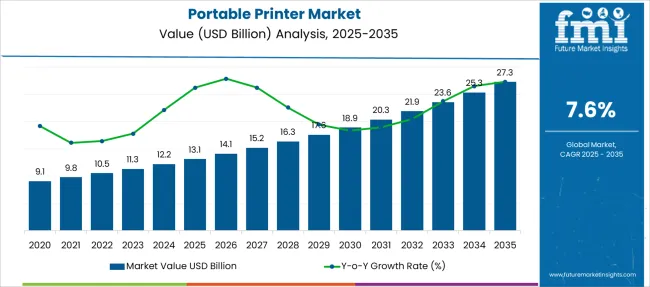
| Metric | Value |
|---|---|
| Portable Printer Market Estimated Value in (2025 E) | USD 13.1 billion |
| Portable Printer Market Forecast Value in (2035 F) | USD 27.3 billion |
| Forecast CAGR (2025 to 2035) | 7.6% |
The portable printer market is expanding steadily, driven by the growing need for mobility, real-time printing, and on-the-go documentation across various industries. Increased field service operations, digital transformation in logistics, and demand for compact, wireless-enabled devices have strengthened market penetration globally.
Manufacturers are focusing on rugged, lightweight, and high-efficiency models to meet the operational needs of mobile workforces. Adoption has further been encouraged by integration with enterprise software, enhanced battery life, and improved thermal printing technologies that reduce maintenance and consumable costs.
As industries increasingly shift to paperless ecosystems, portable printers are emerging as critical tools for producing on-demand, tamper-proof labels, receipts, and tickets. The market is poised for future growth through advancements in wireless connectivity, cross-platform integration, and the increasing focus on durable, weather-resistant designs tailored to outdoor environments.
The market is segmented by Printing Technology, Connecting Technology, and End-User Industry and region. By Printing Technology, the market is divided into Direct Thermal, Thermal Transfer, and Others. In terms of Connecting Technology, the market is classified into Bluetooth and Other Wireless Network Technology. Based on End-User Industry, the market is segmented into Transportation & Logistics, Hospitals & Healthcare, Law Enforcement, Manufacturing, Retail, and Others. Regionally, the market is classified into North America, Latin America, Western Europe, Eastern Europe, Balkan & Baltic Countries, Russia & Belarus, Central Asia, East Asia, South Asia & Pacific, and the Middle East & Africa.
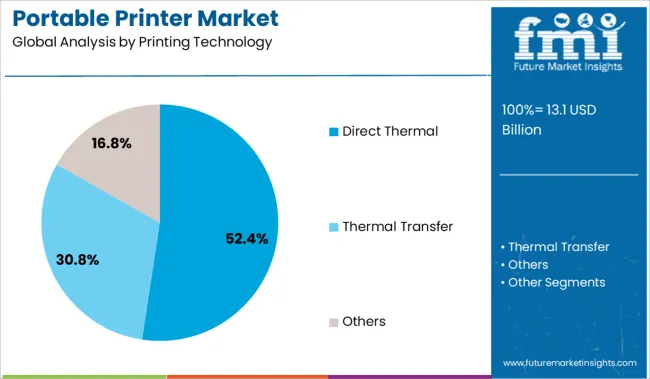
Direct thermal technology is expected to lead the portable printer market with a 52.4% revenue share in 2025. This dominance is being reinforced by the technology’s simplicity, cost-effectiveness, and low-maintenance characteristics.
Since it eliminates the need for ink, toner, or ribbon, direct thermal printing has become the preferred choice for short-term labeling and receipt printing in fast-paced environments. High print speeds, reduced mechanical complexity, and lower total cost of ownership have driven its adoption in transportation, retail, and warehousing applications.
Its suitability for printing scannable barcodes and durable labels under varying environmental conditions has further strengthened its market position. Continued innovation in heat-sensitive paper quality and printer durability is expected to support the long-term expansion of this segment.
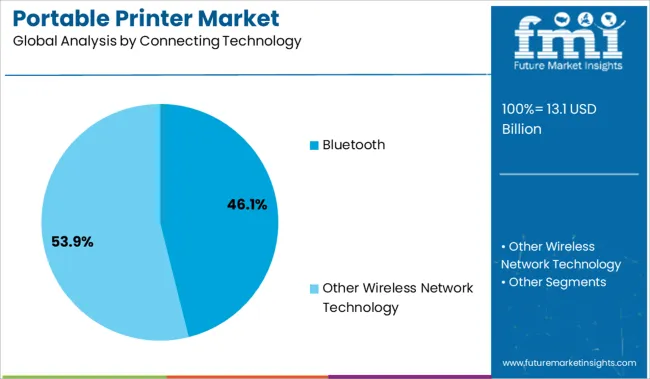
Bluetooth connectivity is projected to capture 46.1% of the total market revenue in 2025, making it the most widely used connection technology in portable printers. Its leadership has been driven by universal compatibility across smartphones, tablets, and handheld scanners, enabling seamless integration in mobile operations.
The ability to maintain a stable connection without cables has improved efficiency for on-the-go professionals, particularly in logistics, retail, and field services. Advancements in Bluetooth Low Energy (BLE) have extended battery life and reduced latency, making the technology even more suitable for continuous use.
As businesses expand remote workflows and mobile transaction processing, Bluetooth’s plug-and-play simplicity and wide adoption in operating systems ensure it remains the go-to standard for wireless portable printing.
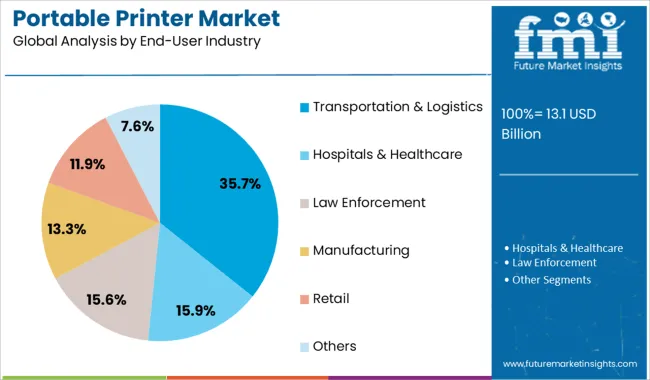
The transportation and logistics sector is expected to contribute 35.7% of total revenue in the portable printer market by 2025, emerging as the leading end-user industry. This prominence is being driven by rising demand for real-time shipping labels, delivery receipts, and barcode generation in transit.
Portable printers are enabling last-mile delivery personnel and warehouse workers to operate efficiently by reducing time spent at centralized print stations. The growing emphasis on supply chain visibility, route optimization, and proof-of-delivery systems has further reinforced reliance on mobile printing solutions.
Integration with fleet management software and tracking applications is facilitating wider deployment across logistics networks. The need for high-volume, durable, and weather-resistant printing has positioned portable printers as indispensable tools in streamlining transportation workflows.
The global demand for the portable printer is projected to increase at a CAGR of 7.6% during the forecast period between 2025 and 2035, reaching a total of USD 21,909 Million in 2035, according to a report from Future Market Insights (FMI). From 2020 to 2024, sales witnessed significant growth, registering a CAGR of 5.2%.
The growing number of mobile workers is a major element driving the worldwide portable printer market. Portable printers, ranging from small handheld versions to big cart-mounted printers, use wireless network connections. Portable printers come in a variety of shapes and sizes, allowing them to work in a variety of settings.
Portable printers, like stationary printers, are simple to operate, lightweight, and robust, with the high print quality and support for a wide range of media.
Portable printers can be linked to a local area network (LAN) using an 802.11b/g wireless interface, and they can accept commands from smartphones, laptops, and tablets via both cabled and wireless connections.
Portable printers are used to print specific printing applications such as barcode/RFID labels, tags, tickets, and receipts, which need fine-tuning of characteristics such as the printer's print speed and darkness setting, which are not available on standard office printers.
Work-from-home and remote working popularity will fuel market growth
During the pandemic, a huge number of enterprises in the Asia Pacific area shifted to remote working. Employees needed the necessary tools to help them transition to a mobile workforce. Sales, logistics, and retail, in particular, require quick printing of receipts, tokens, tickets, invoices, shipping labels, barcodes, and so on, boosting the demand for portable printers.
Furthermore, the worldwide portable printer market is expected to be pushed by increased internet penetration globally. An estimated 13.1 billion IoT devices (smart devices connected through the internet) will be deployed globally by 2025. In addition, the rising usage of smart gadgets and portable electronics will boost the market growth in the next years.
The Expansion of Online Industries will Drive Portable Printer Market Development throughout the Projected Period
Online companies such as e-commerce, online meal delivery services, grocery delivery services, and logistics have gained major traction in recent years, particularly in Asia Pacific and Latin America's rising markets. Brazil, Mexico, China, South Korea, India, and ASEAN nations are among them.
Along with e-receipts, these organizations must meet consumer demands for on-demand barcode, receipt, and label printing, which is projected to continue in the coming years and boost the portable printer market expansion.
The High Cost of Research is projected to limit Worldwide Market Expansion
For the portable printer industry to benefit from market trends, innovation is required. This needs design centers and a well-established Research and Development staff. The cost of research varies according to geography, as does the cost of production. This is expected to stifle market expansion to some degree.
However, due to their existing research institutions, Europe and the USA are projected to lead the industry. Asian nations such as China, Taiwan, and the Philippines have lately begun to expand innovation centers and units to produce technologically superior portable printers, which will aid the market in overcoming restrictions.
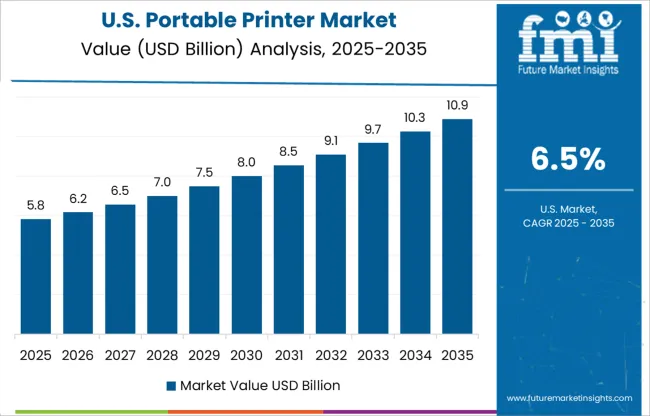
North America is expected to dominate the market by acquiring the highest market share of 25.3% during the forecast period. Owing to the constant focus on improving customer experience and mobile worker efficiency in the USA is accelerating the demand for a portable printers.
In addition, increased usage of portable printers in the retail and healthcare sector is the key factor driving the USA portable printer market size. Moreover, the growing BYOD policy in the USA is the top factor that drives the market share. The key players are investing in the portable printer with rising smart devices flourishing the USA portable printer market growth.
Europe is likely to secure a share of 19.8% in the portable printer market during the forecast period. The rising healthcare, retail, and transport industry in the United Kingdom& is likely to increase the adoption of the portable printer during the forecast period.
Moreover, the key manufacturers are focusing on the innovation of portable printers with modern technology to work faster and more accurately during the forecast period.
Cloudprinter.com is the world's premier Print API for Web2Print providers, E-commerce solutions, Enterprises, and publishers. Cloudprinter.com, with offices in the Netherlands, Denmark, and Ukraine, is establishing a global network of 170+ print partners for local printing.
With our services and solutions, you may print flyers, posters, brochures, picture albums, and over 5000 more goods internationally. Cloudprinter.com helps you save money on shipping, cut transit times, and minimize CO2 emissions.
Asia Pacific portable printer market is expected to accumulate a significant market share of 12% during the forecast
Korean market is likely to secure a significant share in the region by rising numbers of mobile users during the forecast period. With the increasing emphasis on simplifying receipt and order administration, the Korean portable printer market share surging in recent years.
Korea is one of the fastest growing countries, which contributes phenomenal CAGR in the region by rising numbers of small enterprises. Moreover, growing numbers of key manufacturing industries and rising start-ups are adding value to the market and are likely to increase the adoption of the portable printer in Korea.
Japan is known for its highly advanced technology in the region. However, it secures the maximum share of the portable printer market in the region during the forecast period. Rising portable printers and growing demand for the mobile printer is key factors that accelerate the market share.
The rise in adoption of small, smart, and movable devices is flourishing the market size. Moreover, consumers' attraction towards the devices due to their great flexibility, accuracy, and productivity is increasing the Japan portable printer market growth during the forecast period.
The key manufacturers are using several marketing tactics in Japan to uplift the size of the market through acquisitions, mergers, and product launches in the market.
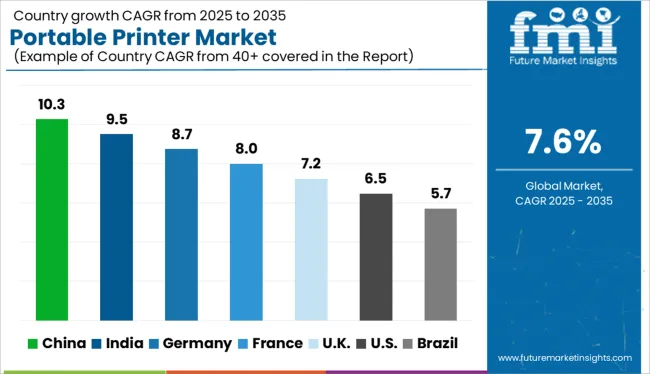
Constant Focus on Improving Customer Experience to Fuel the Market Growth
The portable printer market in North America is expected to accumulate the highest market share of 25.3% in 2025. Owing to the constant focus on improving customer experience and mobile worker efficiency, North America, is likely to provide a large market share. The USA Because of the increased usage of portable printers in the retail and healthcare sectors is the dominant country in the North American area.
Increasing Number of Mobile Users Fuel the Market Growth
The portable printer market in Asia Pacific is expected to accumulate a significant market share of 12% in 2025 and is expected to continue to maintain the trend over the forecast period as well.
Because of the rising number of mobile users and the increased emphasis on simplifying receipt and order administration, Asia Pacific is expected to be the fastest-growing portable printer market.
The Asia Pacific region's market has been steadily growing due to an expanding mobile workforce and a rising need for easier receipts for order management. China alone is predicted to develop at a phenomenal CAGR between 2025 and 2035. Another element contributing to development in this region is the rising number of small enterprises operating online and start-ups.
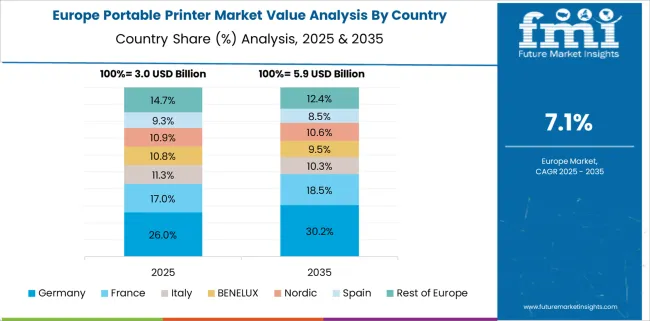
The portable printer market in Europe is expected to accumulate a market share value of 19.8% in 2025. Due to the constant focus on improving customer experience and mobile workforce productivity, Europe is likely to contribute a large market share.
The Thermal Printing Segment to Drive the Portable Printer Market
The printing technology category is separated into three categories: direct thermal, thermal transfer, and others. The thermal portable printer category grabbed the most market share in the entire portable printer industry.
The Transportation & Logistics Segment is Gaining the Most Traction
On the basis of the end-user industry portable printer is categorized into transportation & logistics, hospitals & healthcare, law enforcement, manufacturing, retail, and others. The transportation & logistics sector accounted for the lion’s share in the portable printers market and is anticipated to gain maximum traction during the forecast period.
The increased demand from the healthcare, logistics, e-commerce, and hospitality industries will propel this sector’s growth to new heights. Furthermore, the popularity of portable printers is rapidly expanding. Many businesses are using portable printers for their staff in order to boost productivity and operations. As a result, all of these factors will contribute to the portable printer market's rapid expansion.
Start-ups and their innovations are driving some of the most recent advances in the portable printer sector.
A portable printer gives the consumer actionable innovation intelligence and highlights some of the companies. Let's have a look at some of the primary areas of innovation in this industry:
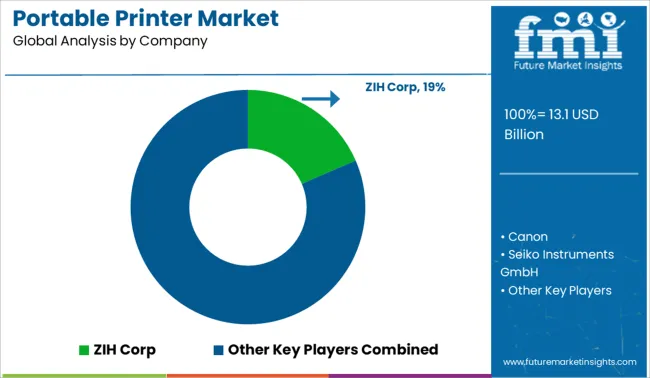
ZIH Corp, Canon, Seiko Instruments GmbH, Toshiba TEC Corporation, Brother United Kingdom Ltd, HP Development Company, L.P., Epson, PrinterOn Inc., Fujifilm Holdings Corporation, and Polaroid are some of the important participants in the worldwide Portable Printer Market.
Recent Developments:
| Report Attribute | Details |
|---|---|
| Growth Rate | CAGR of 7.6% from 2025 to 2035 |
| Market Value in 2025 | USD 10,522 Million |
| Market Value in 2035 | USD 21,909 Million |
| Base Year for Estimation | 2024 |
| Historical Data | 2020 to 2024 |
| Forecast Period | 2025 to 2035 |
| Quantitative Units | Revenue in USD Million and CAGR from 2025 to 2035 |
| Report Coverage | Revenue Forecast, Company Ranking, Competitive Landscape, Growth Factors, Trends, and Pricing Analysis |
| Segments Covered | Printing Technology, Connecting Technology, End-User Industry, Region |
| Regions Covered | North America; Latin America; Europe; East Asia; South Asia; Oceania; Middle East & Africa |
| Key Countries Profiled | USA, Canada, Brazil, Mexico, Germany, United Kingdom, France, Spain, Italy, Russia, Poland, China, Japan, South Korea, India, Malaysia, Singapore, Thailand, Australia, New Zealand, GCC Countries, South Africa, Israel |
| Key Companies Profiled | ZIH Corp; Canon; Seiko Instruments GmbH; Toshiba TEC Corporation; Brother United Kingdom Ltd; HP Development Company; L.P. Printing; Epson; PrinterOn Inc.; Fujifilm Holdings Corporation; Polaroid |
| Customization & Pricing | Available upon Request |
The global portable printer market is estimated to be valued at USD 13.1 billion in 2025.
The market size for the portable printer market is projected to reach USD 27.3 billion by 2035.
The portable printer market is expected to grow at a 7.6% CAGR between 2025 and 2035.
The key product types in portable printer market are direct thermal, thermal transfer and others.
In terms of connecting technology, bluetooth segment to command 46.1% share in the portable printer market in 2025.






Full Research Suite comprises of:
Market outlook & trends analysis
Interviews & case studies
Strategic recommendations
Vendor profiles & capabilities analysis
5-year forecasts
8 regions and 60+ country-level data splits
Market segment data splits
12 months of continuous data updates
DELIVERED AS:
PDF EXCEL ONLINE
Portable Crushers Market Size and Share Forecast Outlook 2025 to 2035
Portable Filtration System Market Size and Share Forecast Outlook 2025 to 2035
Portable Toilet Rental Market Size and Share Forecast Outlook 2025 to 2035
Portable NIR Moisture Meter Market Forecast and Outlook 2025 to 2035
Portable Appliance Tester (PAT) Market Size and Share Forecast Outlook 2025 to 2035
Portable Boring Machines Market Size and Share Forecast Outlook 2025 to 2035
Portable Charging Units Market Size and Share Forecast Outlook 2025 to 2035
Portable Electronic Analgesic Pump Market Size and Share Forecast Outlook 2025 to 2035
Portable Ramps Market Size and Share Forecast Outlook 2025 to 2035
Portable Buffet and Drop-In Ranges Market Size and Share Forecast Outlook 2025 to 2035
Portable Cancer Screen Devices Market Size and Share Forecast Outlook 2025 to 2035
Portable Hydrogen Powered Generator Market Size and Share Forecast Outlook 2025 to 2035
Portable Milling Machine Market Size and Share Forecast Outlook 2025 to 2035
Portable Power Quality Meter Market Size and Share Forecast Outlook 2025 to 2035
Portable Sandwich Maker Market Size and Share Forecast Outlook 2025 to 2035
Portable Conventional Generator Market Size and Share Forecast Outlook 2025 to 2035
Portable Projector Market Size and Share Forecast Outlook 2025 to 2035
Portable Video Wall Market Size and Share Forecast Outlook 2025 to 2035
Portable Gas Detection Equipment Market Size and Share Forecast Outlook 2025 to 2035
Portable Chromatography Systems Market Size and Share Forecast Outlook 2025 to 2035

Thank you!
You will receive an email from our Business Development Manager. Please be sure to check your SPAM/JUNK folder too.
Chat With
MaRIA